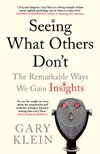
Saved by Margaux Capo and
Seeing What Others Don't: The remarkable ways we gain INSIGHTS

Saved by Margaux Capo and
When trying to understand why people acted in a certain way, you might use a short checklist to guide your probing: their knowledge, beliefs and experience, motivation and competing priorities, and their constraints.
they don’t excavate the entire hill. That level of effort would be too costly and take too long. Instead, they dig a trench that gives them a snapshot of what’s inside the hill. It helps them assess whether the site has walls or housing materials or any other significant structures. The archaeologists may judge that the hill is not worth further in
... See moreRather than retreating all the way to the left, strategy A in the diagram, scientists, intelligence analysts, and others could use a different strategy: to make the most extreme statements that they can defend, strategy B.
The connection path thrives on having lots of ideas swirling around and on making accidental linkages.
To improve performance, we need to reduce errors and uncertainty and we need to increase insights. Unfortunately, the two arrows often conflict with each other. The actions we take to reduce errors and uncertainty can get in the way of insights.
The shifts changed some of the core beliefs the five people initially held. During this transition some initial beliefs were abandoned or replaced. The shifts were discontinuous discoveries—unexpected transitions from a mediocre story to a better one.
All these cases (Yamamoto, Stark, Chalfie, Gopnik, Darwin, and Wallace) follow a connection strategy for making insights. The person making the discovery gets some new piece of information and sees how it combines with other information to form a new idea.
Next comes the illumination stage, when insight bursts forth with conciseness, suddenness, and immediate certainty. Wallas believed that the insight, the “happy idea,” was the culmination of a train of unconscious associations. These associations had to mature outside of conscious scrutiny until they were ready to surface.
Examples such as this illustrate why we shouldn’t put too much faith in the evidence. We don’t know all the conditions that can affect and contaminate evidence, even if the data samples are carefully collected.